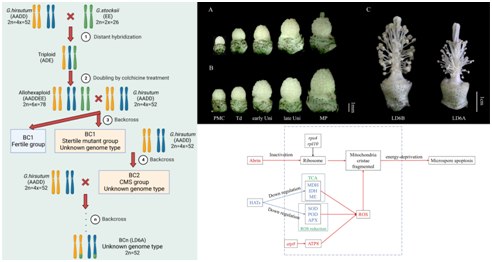- Location : Home» Newsroom
Discovery of a novel mechanism of male sterility in upland cotton shed light on creating new germplasm resources
The Chinese Academy of Agricultural Sciences has made a significant discovery regarding the mechanism of male sterility in upland cotton. Identifying a novel sterile line with a genetic background of wild cotton, the study sheds light on the pollen abortion mechanism and presents a theoretical basis for creating new type of sterile line and utilizing heterosis of wild cotton through distant hybridization. The findings have been published in the journal of Industrial Crops and Products.
Cotton yield advancement is currently threatened by the availability of CMS germplasm. In this study, researchers employed cytological, physiological and proteomic approaches to understand the CMS mechanism in the LD6A CMS line and its maintainer line, LD6B, of upland cotton. Differential expressed proteins (DEPs) such as Abrin, MDH (malate dehydrogenase), ME (malic enzyme), IDH (isocitrate dehydrogenase), HAT (histone acetyltransferases), were found significantly enriched in pathways including starch and sucrose metabolism, ribosome, proteome, oxidative phosphorylation, and nucleotide excision repair. Comparative observation of mitochondrial structures between LD6A and LD6B in anther tapetum by transmission electron microscope (TEM) revealed that the inner ridge of mitochondria in the CMS line was unclear, and the space between membrane was narrow in the tetrad (Td) stage. Furthermore, higher reactive oxygen species (ROS) accumulation was observed in the anther of the CMS line compared to its maintainer line at pollen mother cell (PMC) and tetrad stage. These results indicate that the abnormal sequence of mitochondrial ribosome gene rps4 and rpl10, along with the high expression of the ribosome inactivating protein gene Abrin in the CMS line, damaged mitochondrial membrane and induced pollen sterility. Overall, these findings provide new insight into CMS mechanisms in cotton crops and offer a tool to develop new CMS germplasm resources. The study has significant implications for improving cotton yield and will benefit researchers and practitioners in the field of cotton breeding.
